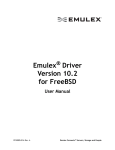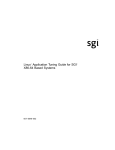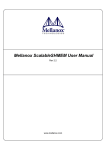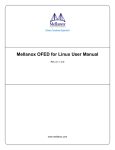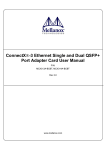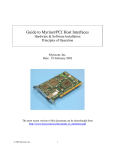Download Mellanox OFED for FreeBSD User Manual
Transcript
Mellanox OFED for FreeBSD
User Manual
Rev 2.1.6
www.mellanox.com
Rev 2.1.6
NOTE:
THIS HARDWARE, SOFTWARE OR TEST SUITE PRODUCT (“PRODUCT(S)”) AND ITS RELATED
DOCUMENTATION ARE PROVIDED BY MELLANOX TECHNOLOGIES “AS-IS” WITH ALL FAULTS OF ANY
KIND AND SOLELY FOR THE PURPOSE OF AIDING THE CUSTOMER IN TESTING APPLICATIONS THAT USE
THE PRODUCTS IN DESIGNATED SOLUTIONS. THE CUSTOMER'S MANUFACTURING TEST ENVIRONMENT
HAS NOT MET THE STANDARDS SET BY MELLANOX TECHNOLOGIES TO FULLY QUALIFY THE PRODUCT(S)
AND/OR THE SYSTEM USING IT. THEREFORE, MELLANOX TECHNOLOGIES CANNOT AND DOES NOT
GUARANTEE OR WARRANT THAT THE PRODUCTS WILL OPERATE WITH THE HIGHEST QUALITY. ANY
EXPRESS OR IMPLIED WARRANTIES, INCLUDING, BUT NOT LIMITED TO, THE IMPLIED WARRANTIES OF
MERCHANTABILITY, FITNESS FOR A PARTICULAR PURPOSE AND NONINFRINGEMENT ARE DISCLAIMED.
IN NO EVENT SHALL MELLANOX BE LIABLE TO CUSTOMER OR ANY THIRD PARTIES FOR ANY DIRECT,
INDIRECT, SPECIAL, EXEMPLARY, OR CONSEQUENTIAL DAMAGES OF ANY KIND (INCLUDING, BUT NOT
LIMITED TO, PAYMENT FOR PROCUREMENT OF SUBSTITUTE GOODS OR SERVICES; LOSS OF USE, DATA,
OR PROFITS; OR BUSINESS INTERRUPTION) HOWEVER CAUSED AND ON ANY THEORY OF LIABILITY,
WHETHER IN CONTRACT, STRICT LIABILITY, OR TORT (INCLUDING NEGLIGENCE OR OTHERWISE)
ARISING IN ANY WAY FROM THE USE OF THE PRODUCT(S) AND RELATED DOCUMENTATION EVEN IF
ADVISED OF THE POSSIBILITY OF SUCH DAMAGE.
Mellanox Technologies
350 Oakmead Parkway Suite 100
Sunnyvale, CA 94085
U.S.A.
www.mellanox.com
Tel: (408) 970-3400
Fax: (408) 970-3403
© Copyright 2015. Mellanox Technologies. All Rights Reserved.
Mellanox®, Mellanox logo, BridgeX®, ConnectX®, Connect-IB®, CoolBox®, CORE-Direct®, GPUDirect®, InfiniBridge®,
InfiniHost®, InfiniScale®, Kotura®, Kotura logo, MetroX®, MLNX-OS®, PhyX®, ScalableHPC®, SwitchX®, TestX®,
UFM®, Virtual Protocol Interconnect®, Voltaire® and Voltaire logo are registered trademarks of Mellanox Technologies,
Ltd.
CyPU™, ExtendX™, FabricIT™, FPGADirect™, HPC-X™, Mellanox Care™, Mellanox CloudX™, Mellanox Open
Ethernet™, Mellanox PeerDirect™, Mellanox Virtual Modular Switch™, MetroDX™, NVMeDirect™, StPU™,
Switch-IB™, Unbreakable-Link™ are trademarks of Mellanox Technologies, Ltd.
All other trademarks are property of their respective owners.
2
Mellanox Technologies
Document Number: 2950
Rev 2.1.6
Table of Contents
Table of Contents . . . . . . . . . . . . . . . . . . . . . . . . . . . . . . . . . . . . . . . . . . . . . . . . . . . . . . . . . . 3
List of Tables . . . . . . . . . . . . . . . . . . . . . . . . . . . . . . . . . . . . . . . . . . . . . . . . . . . . . . . . . . . . . 4
Document Revision History . . . . . . . . . . . . . . . . . . . . . . . . . . . . . . . . . . . . . . . . . . . . . . . . . 5
About this Manual . . . . . . . . . . . . . . . . . . . . . . . . . . . . . . . . . . . . . . . . . . . . . . . . . . . . . . . . . 6
Chapter 1 Overview . . . . . . . . . . . . . . . . . . . . . . . . . . . . . . . . . . . . . . . . . . . . . . . . . . . . . . . 9
1.1
Mellanox OFED for FreeBSD Package Contents . . . . . . . . . . . . . . . . . . . . . . . . . 9
1.1.1 Tarball Package. . . . . . . . . . . . . . . . . . . . . . . . . . . . . . . . . . . . . . . . . . . . . . . . . . . . 9
1.1.2 mlx4 driver . . . . . . . . . . . . . . . . . . . . . . . . . . . . . . . . . . . . . . . . . . . . . . . . . . . . . . . 9
Chapter 2 Installation . . . . . . . . . . . . . . . . . . . . . . . . . . . . . . . . . . . . . . . . . . . . . . . . . . . . 11
2.1
2.2
2.3
2.4
2.5
Software Dependencies . . . . . . . . . . . . . . . . . . . . . . . . . . . . . . . . . . . . . . . . . . . .
Downloading Mellanox Driver for FreeBSD . . . . . . . . . . . . . . . . . . . . . . . . . . .
Installing Mellanox Driver for FreeBSD . . . . . . . . . . . . . . . . . . . . . . . . . . . . . . .
Firmware Programming. . . . . . . . . . . . . . . . . . . . . . . . . . . . . . . . . . . . . . . . . . . .
11
11
11
13
2.4.1
2.4.2
2.4.3
2.4.4
13
14
14
14
Installing Firmware Tools . . . . . . . . . . . . . . . . . . . . . . . . . . . . . . . . . . . . . . . . . . .
Downloading Firmware . . . . . . . . . . . . . . . . . . . . . . . . . . . . . . . . . . . . . . . . . . . .
Updating Firmware Using flint . . . . . . . . . . . . . . . . . . . . . . . . . . . . . . . . . . . . . . .
Updating Firmware Using mlxburn (.mlx file) . . . . . . . . . . . . . . . . . . . . . . . . . . .
Driver Usage and Configuration . . . . . . . . . . . . . . . . . . . . . . . . . . . . . . . . . . . . . 14
Chapter 3 Features Overview and Configuration . . . . . . . . . . . . . . . . . . . . . . . . . . . . . 17
3.1
Ethernet Network. . . . . . . . . . . . . . . . . . . . . . . . . . . . . . . . . . . . . . . . . . . . . . . . . 17
3.1.1 RDMA over Converged Ethernet (RoCE) . . . . . . . . . . . . . . . . . . . . . . . . . . . . . . 17
3.1.2 Packet Pacing . . . . . . . . . . . . . . . . . . . . . . . . . . . . . . . . . . . . . . . . . . . . . . . . . . . . 18
3.1.3 EEPROM Cable Module Information Reader . . . . . . . . . . . . . . . . . . . . . . . . . . . 21
Chapter 4 Performance Tuning . . . . . . . . . . . . . . . . . . . . . . . . . . . . . . . . . . . . . . . . . . . . 22
4.1
4.2
Interrupt Moderation . . . . . . . . . . . . . . . . . . . . . . . . . . . . . . . . . . . . . . . . . . . . . . 22
Tuning for NUMA Architecture . . . . . . . . . . . . . . . . . . . . . . . . . . . . . . . . . . . . . 22
4.2.1 Single NUMA Architecture . . . . . . . . . . . . . . . . . . . . . . . . . . . . . . . . . . . . . . . . . 22
4.2.2 Dual NUMA Architecture. . . . . . . . . . . . . . . . . . . . . . . . . . . . . . . . . . . . . . . . . . . 23
Mellanox Technologies
3
Rev 2.1.6
List of Tables
Table 1:
Table 2:
Table 3:
Table 4:
Table 5:
Document Revision History . . . . . . . . . . . . . . . . . . . . . . . . . . . . . . . . . . . . . . . . . . . . . . . . 5
Abbreviations and Acronyms . . . . . . . . . . . . . . . . . . . . . . . . . . . . . . . . . . . . . . . . . . . . . . . 7
Glossary . . . . . . . . . . . . . . . . . . . . . . . . . . . . . . . . . . . . . . . . . . . . . . . . . . . . . . . . . . . . . . . . 8
Reference Documents . . . . . . . . . . . . . . . . . . . . . . . . . . . . . . . . . . . . . . . . . . . . . . . . . . . . . 8
Mellanox OFED for FreeBSD Software Components . . . . . . . . . . . . . . . . . . . . . . . . . . . . 9
Mellanox Technologies
4
Rev 2.1.6
Document Revision History
Table 1 - Document Revision History
Release
2.1.6
Date
June 2015
Description
•
Added the following sections:
• Section 3.1.3, “EEPROM
Cable Module Information
Reader”, on page 21
•
2.1.5
January 15, 2015
•
Updated the following sections:
• 3.1.2 “Packet Pacing,” on
page 18
Added the following sections:
• Section 3, “Features Overview
and Configuration”, on
page 17
•
5
Mellanox Technologies
Updated the following sections:
• Section 1, “Overview”, on page 9
• Section 2, “Installation”, on page 11
• Section 4, “Performance Tuning”, on
page 22
Rev 2.1.6
About this Manual
This Preface provides general information concerning the scope and organization of this User’s
Manual.
Intended Audience
This manual is intended for system administrators responsible for the installation, configuration,
management and maintenance of the software and hardware of VPI (InfiniBand, Ethernet)
adapter cards. It is also intended for application developers.
Mellanox Technologies
6
Rev 2.1.6
Common Abbreviations and Acronyms
Table 2 - Abbreviations and Acronyms
Abbreviation /
Acronym
Whole Word / Description
B
(Capital) ‘B’ is used to indicate size in bytes or multiples of bytes
(e.g., 1KB = 1024 bytes, and 1MB = 1048576 bytes)
b
(Small) ‘b’ is used to indicate size in bits or multiples of bits (e.g.,
1Kb = 1024 bits)
FW
Firmware
HCA
Host Channel Adapter
HW
Hardware
IB
InfiniBand
LSB
Least significant byte
lsb
Least significant bit
MSB
Most significant byte
msb
Most significant bit
NIC
Network Interface Card
SW
Software
VPI
Virtual Protocol Interconnect
PFC
Priority Flow Control
PR
Path Record
RDS
Reliable Datagram Sockets
RoCE
RDMA over Converged Ethernet
SL
Service Level
QoS
Quality of Service
ULP
Upper Level Protocol
VL
Virtual Lane
Glossary
The following is a list of concepts and terms related to InfiniBand in general and to Subnet Managers in particular. It is included here for ease of reference, but the main reference remains the
7
Mellanox Technologies
Rev 2.1.6
InfiniBand Architecture Specification.
Table 3 - Glossary
Channel Adapter (CA),
Host Channel Adapter
(HCA)
An IB device that terminates an IB link and executes transport functions. This may be an HCA (Host CA) or a TCA (Target CA).
HCA Card
A network adapter card based on an InfiniBand channel adapter
device.
IB Devices
Integrated circuit implementing InfiniBand compliant communication.
In-Band
A term assigned to administration activities traversing the IB connectivity only.
Local Port
The IB port of the HCA through which IBDIAG tools connect to the
IB fabric.
Master Subnet Manager
The Subnet Manager that is authoritative, that has the reference configuration information for the subnet. See Subnet Manager.
Multicast Forwarding
Tables
A table that exists in every switch providing the list of ports to forward received multicast packet. The table is organized by MLID.
Network Interface Card
(NIC)
A network adapter card that plugs into the PCI Express slot and provides one or more ports to an Ethernet network.
Unicast Linear Forwarding Tables (LFT)
A table that exists in every switch providing the port through which
packets should be sent to each LID.
Virtual Protocol Interconnet (VPI)
A Mellanox Technologies technology that allows Mellanox channel
adapter devices (ConnectX®) to simultaneously connect to an InfiniBand subnet and a 10GigE subnet (each subnet connects to one of the
adpater ports)
Related Documentation
Table 4 - Reference Documents
Document Name
Description
InfiniBand Architecture Specification, Vol. 1,
Release 1.2.1
The InfiniBand Architecture Specification that is provided by IBTA
Support and Updates Webpage
Please visit http://www.mellanox.com > Products > Software > Ethernet Drivers > FreeBSD Drivers for downloads, FAQ, troubleshooting, future updates to this manual, etc.
Mellanox Technologies
8
Rev 2.1.6
1
Overview
Overview
This document provides information on the Mellanox driver for FreeBSD and instructions for
installing the driver on Mellanox ConnectX® adapter cards supporting the following uplinks to
servers:
•
ConnectX®-3/ConnectX®-3 Pro:
• InfiniBand: QDR, FDR10, FDR
• Ethernet: 10GigE, 40GigE
The driver release introduces the following capabilities:
•
Single/Dual port
•
Up to 16 Rx queues per port
•
Up to 32 Tx queues per port (according to number of CPUs)
•
MSI-X or INTx
•
Adaptive interrupt moderation
•
Hardware Tx/Rx checksum calculation
•
Large Send Offload (i.e., TCP Segmentation Offload)
•
Large Receive Offload
•
VLAN Tx/Rx acceleration (Hardware VLAN stripping/insertion)
•
Net device statistics
1.1
Mellanox OFED for FreeBSD Package Contents
1.1.1
Tarball Package
Mellanox OFED for FreeBSD package includes the following directories:
1.1.2
•
modules - contains the relevant Makefiles
•
ofed - source code
mlx4 driver
mlx4 is the low level driver implementation for the ConnectX adapters designed by Mellanox
Technologies. The ConnectX® can operate as an InfiniBand adapter and as an Ethernet NIC.
1.1.2.1 Software Components
Mellanox OFED for FreeBSD contains the following software components:
Table 5 - Mellanox OFED for FreeBSD Software Components
Components
9
Description
mlx4_core
Handles low-level functions like device initialization and firmware commands
processing. Also controls resource allocation so that the InfiniBand, Ethernet and
FC functions can share a device without interfering with each other.
mlx4_en
Handles Ethernet specific functions and plugs into the netdev mid-layer.
Mellanox Technologies
Rev 2.1.6
Table 5 - Mellanox OFED for FreeBSD Software Components
Components
Description
mlx4_ib
Handles InfiniBand specific functions supplied by ib_core in order to interact with
verbs and ULPs.
Documentation
Release Notes, User Manual
Mellanox Technologies
10
Rev 2.1.6
2
Installation
Installation
This chapter describes how to install and test the Mellanox driver for FreeBSD package on a single host machine with Mellanox InfiniBand and/or Ethernet adapter hardware installed.
2.1
2.2
Software Dependencies
•
To install the driver software, kernel sources must be installed on the machine.
•
To run the Packet Pacing feature, the kernel patch and dedicated FW version included in
the Packet Pacing package need to be applied.
Downloading Mellanox Driver for FreeBSD
1. Verify that the system has a Mellanox network adapter (HCA/NIC) installed.
The following example shows a system with an installed Mellanox HCA:
# pciconf -lv | grep Mellanox -C 3
mlx4_core0@pci0:7:0:0: class=0x028000 card=0x000615b3 chip=0x100315b3 rev=0x00 hdr=0x00
vendor
= 'Mellanox Technologies'
device
= 'MT27500 Family [ConnectX-3]'
class
= network
2. Download the tarball image to your host.
The image name has the format MLNX_OFED_FreeBSD-<ver>.tgz. You can download it from
http://www.mellanox.com > Products > Software > Ethernet Drivers > FreeBSD
or
http://www.mellanox.com > Products > Software > InfiniBand/VPI drivers > FreeBSD
3. Use the md5sum utility to confirm the file integrity of your tarball image.
2.3
Installing Mellanox Driver for FreeBSD
Prior to installing the driver, please re-compile (and install) the kernel with NO OFED options/
devices enabled.
1. Extract the tarball.
2. Compile and load needed modules in the following order of dependencies:
• Ethernet Driver:
mlx4_core
a.Go to the mlx4 directory. Run:
# cd modules/mlx4
b. Clean any previous dependencies. Run:
# make -m $HEAD/share/mk SYSDIR=$HEAD/sys clean cleandepend
11
Mellanox Technologies
Rev 2.1.6
c. Compile the mlx4_core module. Run:
# make -m $HEAD/share/mk SYSDIR=$HEAD/sys
Note: For packet pacing support, add CONFIG_RATELIMIT=yes. This option has a kernel patch
dependency.
d. Install the mlx4_core module. Run:
# make -m $HEAD/share/mk SYSDIR=$HEAD/sys install
e. Load the mlx4_core module. Run:
# kldload mlx4
mlxen
a.Go to the mlxen directory. Run:
# cd modules/mlxen
b. Clean any previous dependencies. Run:
# make -m $HEAD/share/mk SYSDIR=$HEAD/sys clean cleandepend
c. Compile the mlxen module. Run:
# make -m $HEAD/share/mk SYSDIR=$HEAD/sys
Note: For packet pacing support, add CONFIG_RATELIMIT=yes. This option has a kernel patch
dependency.
d. Install the mlxen module. Run:
# make -m $HEAD/share/mk SYSDIR=$HEAD/sys install
e. Load the mlxen module. Run:
# kldload mlxen
• InfiniBand Driver:
mlx4_core
Run the same steps as specified for Ethernet driver above.
ib_core
a.Go to the ib_core directory. Run:
# cd modules/ibcore
b. Clean any previous dependencies. Run:
# make -m $HEAD/share/mk SYSDIR=$HEAD/sys clean cleandepend
c. Compile the ib_core module. Run:
# make -m $HEAD/share/mk SYSDIR=$HEAD/sys
d. Install the ib_core module. Run:
# make -m $HEAD/share/mk SYSDIR=$HEAD/sys install
e. Load the ib_core module. Run:
# kldload ibcore
mlx4_ib
a.Go to the mlx4_ib directory. Run:
# cd modules/mlx4ib
Mellanox Technologies
12
Rev 2.1.6
Installation
b. Clean any previous dependencies. Run:
# make -m $HEAD/share/mk SYSDIR=$HEAD/sys clean cleandepend
c. Compile the mlx4_ib module. Run:
# make -m $HEAD/share/mk SYSDIR=$HEAD/sys
d. Install the mlx4_ib module. Run:
# make -m $HEAD/share/mk SYSDIR=$HEAD/sys install
e. Load the mlx4_ib module. Run:
# kldload mlx4ib
ipoib
a.Go to the ipoib directory. Run:
# cd modules/ipoib
b. Clean any previous dependencies. Run:
# make -m $HEAD/share/mk SYSDIR=$HEAD/sys clean cleandepend
c. Compile the ipoib module. Run:
# make -m $HEAD/share/mk SYSDIR=$HEAD/sys
d. Install the ipoib module. Run:
# make -m $HEAD/share/mk SYSDIR=$HEAD/sys install
e. Load the ipoib module. Run:
# kldload ipoib
To load a module on reboot, add "mlx4_load=="YES"/mlxen_load="YES"/ibcore_load="YES"/
mlx4ib_load="YES"/ipoib="YES"" to the '/boot/ loader.conf' file (create if does not exist).
Run "kldstat" in order to verify which modules are loaded on your server.
2.4
Firmware Programming
The adapter card was shipped with the most current firmware available. This section is intended
for future firmware upgrades, and provides instructions for (1) installing Mellanox firmware
update tools (MFT), (2) downloading FW, and (3) updating adapter card firmware.
2.4.1
13
Installing Firmware Tools
Step 1.
Download the current Mellanox Firmware Tools package (MFT) from
www.mellanox.com > Products > Adapter IB/VPI SW > Firmware Tools.
The tools package to download is "MFT_SW for FreeBSD" (tarball name is mft-X.X.X.tgz).
Step 2.
Extract the tarball and run the installation script.
Mellanox Technologies
Rev 2.1.6
2.4.2
Downloading Firmware
1. Retrieve device's PCI slot (i.e. pci0:x:0:0). Run:
$ mst status
2. Verify your card’s PSID.
$flint -d <pci> q
3. Download the desired firmware from the Mellanox website.
http://www.mellanox.com/page/firmware_download
2.4.3
Updating Firmware Using flint
1. Unzip the firmware binary file:
$flint -d <pci> -i <img.bin> b
2. Reboot the server.
2.4.4
Updating Firmware Using mlxburn (.mlx file)
1. Extract the relevant firmware package (ConnectX3/ConnectX3-Pro).
2. From the extracted directory, run:
$mlxburn -d <NIC's_pci_slot> -fw <.mlx file> -conf_dir_list .
Example
$mlxburn -d <NIC's_pci_slot> -fw fw-ConnectX3-rel.mlx -conf_dir_list .
3. Reboot the server.
2.5
Driver Usage and Configuration
To assign an IP address to the interface:
#> ifconfig mlxen<x> <ip>
Note: <x> is the OS assigned interface number
To check driver and device information:
#> pciconf -lv | grep mlx
#> flint -d pci<w:x:y:z> q
Example:
#> pciconf -lv | grep mlx
mlx4_core0@pci0:7:0:0: class=0x028000 card=0x003715b3 chip=0x100315b3 rev=0x00 hdr=0x00
#> flint -d pci0:7:0:0 q
Image type:
FS2
FW Version:
2.11.1294
Device ID:
4099
Description:
Node
Port1
Port2
Sys image
GUIDs:
0002c903002ffcc0 0002c903002ffcc1 0002c903002ffcc2 0002c903002ffcc3
MACs:
0002c92ffcc0
0002c92ffcc1
VSD:
PSID:
MT_1020120019
Mellanox Technologies
14
Rev 2.1.6
Installation
To check driver version:
#> dmesg
Example:
#> dmesg
mlx4_core: Mellanox ConnectX core driver v2.1 (Aug 21 2014)
mlx4_en: Mellanox ConnectX HCA Ethernet driver v2.1 (Aug 18 2014)
To query stateless offload status:
#> ifconfig mlxen<x>
Note: <x> is the OS assigned interface number
To set stateless offload status:
#> ifconfig mlxen<x> [rxcsum|-rxcsum] [txcsum|-txcsum] [tso|-tso] [lro|-lro]
Note: <x> is the OS assigned interface number
To query interrupt coalescing settings:
#> sysctl -a | grep adaptive
Example:
#> sysctl -a | grep adaptive
hw.mlxen0.conf.adaptive_rx_coal: 1
hw.mlxen1.conf.adaptive_rx_coal: 1
To enable/disable adaptive interrupt moderation:
#>sysctl hw.mlxen<x>.conf.adaptive_rx_coal=[1/0]
Note: <x> is the OS assigned interface number
By default, the driver uses adaptive interrupt moderation for the receive path, which adjusts the
moderation time to the traffic pattern.
To query values for packet rate limits and for moderation time high and low:
#> sysctl -a | grep pkt_rate
#> sysctl -a | grep rx_usecs
To set the values for packet rate limits and for moderation time high and low:
#>
#>
#>
#>
sysctl
sysctl
sysctl
sysctl
hw.mlxen<x>.conf.pkt_rate_low=[N]
hw.mlxen<x>.conf.pkt_rate_high=[N]
hw.mlxen<x>.conf.rx_usecs_low=[N]
hw.mlxen<x>.conf.rx_usecs_high=[N]
Note: <x> is the OS assigned interface number
Example:
#> sysctl -a | grep pkt_rate
hw.mlxen0.conf.pkt_rate_low: 400000
hw.mlxen0.conf.pkt_rate_high: 450000
hw.mlxen1.conf.pkt_rate_low: 400000
hw.mlxen1.conf.pkt_rate_high: 450000
sysctl -a | grep rx_usecs
hw.mlxen0.conf.rx_usecs_low: 0
hw.mlxen0.conf.rx_usecs_high: 128
hw.mlxen1.conf.rx_usecs_low: 0
hw.mlxen1.conf.rx_usecs_high: 128
15
Mellanox Technologies
Rev 2.1.6
Above an upper limit of packet rate, adaptive moderation will set the moderation time to its highest
value. Below a lower limit of packet rate, the moderation time will be set to its lowest value.
To query pause frame settings:
#> ifconfig -m mlxen<x>
Note: <x> is the OS assigned interface number
To set pause frame settings:
#> ifconfig -m mlxen<x> [-]mediaopt [rxpause,txpause]
Note: <x> is the OS assigned interface number
To query ring size values:
#> sysctl -a | grep _size
Example:
#> sysctl -a | grep _size
hw.mlxen0.conf.rx_size: 1024
hw.mlxen0.conf.tx_size: 1024
hw.mlxen1.conf.rx_size: 1024
hw.mlxen1.conf.tx_size: 1024
To modify rings size:
#> sysctl hw.mlxen<x>.conf.rx_size=[N]
#> sysctl hw.mlxen<x>.conf.tx_size=[N]
Note: <x> is the OS assigned interface number
To obtain additional device statistics:
#> sysctl -a | grep mlx | grep stat
The driver defaults to the following parameters:
•
Both ports are activated (i.e., a net device is created for each port)
•
The number of Rx rings for each port is the nearest power of 2 of number of CPU cores,
limited by 16.
•
LRO is enabled with 32 concurrent sessions per Rx ring
Mellanox Technologies
16
Rev 2.1.6
Features Overview and Configuration
3
Features Overview and Configuration
3.1
Ethernet Network
3.1.1
RDMA over Converged Ethernet (RoCE)
RoCE allows InfiniBand (IB) transport applications to work over an Ethernet network. RoCE
encapsulates the InfiniBand transport and the GRH headers in Ethernet packets bearing a dedicated ether type (0x8915). Thus, any VERB application that works in an InfiniBand fabric can
also work in an Ethernet fabric.
RoCE is enabled only for drivers that support VPI (currently, only mlx4).
When working with RDMA applications over Ethernet link layer, the following points
should be noted:
•
The presence of a Subnet Manager (SM) is not required in the fabric. Thus, operations
that require communication with the SM are managed in a different way in RoCE. This
does not affect the API.
•
Since the SM is not present, querying a path is impossible. Therefore, the path record
structure must be filled with the relevant values before establishing a connection.
It is recommended working with RDMA-CM to establish a connection as it takes care
of filling the path record structure.
•
Since LID is a layer 2 attribute of the InfiniBand protocol stack, it is not set for a port
and is displayed as zero when querying the port.
•
With RoCE, APM is not supported.
•
The GID table for each port is populated with N+1 entries where N is the number of IP
addresses that are assigned to all network devices associated with the port including
VLAN devices.
•
The first entry in the GID table (at index 0) for each port is always present and equal to
the link local IPv6 address of the net device that is associated with the port. Note that
even if the link local IPv6 address is not set, index 0 is still populated.
•
GID format can be of 2 types, IPv4 and IPv6. IPv4 GID is a IPv4-mapped IPv6 address1
while IPv6 GID is the IPv6 address itself.
•
Load the following modules for RoCE support: mlx4_core, ib_core, mlx4_ib, and mlx4_en.
1. For the IPv4 address A.B.C.D the corresponding IPv4-mapped IPv6 address is ::ffff.A.B.C.D
17
Mellanox Technologies
Rev 2.1.6
3.1.2
Packet Pacing
Packet pacing, also known as the “rate limit,” defines a maximum bandwidth allowed for a TCP
connection. Limitation is done by hardware where each QP (transmit queue) has a rate limit
value from which it calculates the delay between each packet sent.
3.1.2.1 Setting Properties for Packet Pacing
Before loading mlxen module, set which property (0-7) is relevant for packet pacing sockets.
Run:
kenv hw.mlx4_en.config_prios_for_rl_rings=<#priority>,<#priority>,<#priority>…
For example:
kenv hw.mlx4_en.config_prios_for_rl_rings=0,1,2…
When no priorities are being selected, the default priority supported with packet pacing sockets
would be priority zero.
3.1.2.2 Setting Rates for Packet Pacing
Rates that are being used with packet pacing must be defined in advance.
New Rates Configuration
•
Newly configured rates must be within a certain range, determined by the firmware, and
they can be read through sysctl.
• For a minimum value, run:
#sysctl sys.device.<DEVICE NAME>.rate_limit_caps.min_value
• For a maximum value, run:
#sysctl sys.device.<DEVICE NAME>.rate_limit_caps.max_value
•
The number of configured rates is also determined by the firmware. In order to check
how many rates can be defined, run:
#sysctl hw.<INTERFACE NAME>.conf.num_rates
•
A new rate can be added by any the following methods:
• Add a rate per index (from index 1 to num_rates):
#sysctl hw.<INTERFACE NAME>.conf.rate_limit_1=400000
#sysctl hw.<INTERFACE NAME>.conf.rate_limit_120=500000
In order to read which rate was defined for a specific index (for example, Index 1), run:
#sysctl hw.<INTERFACE NAME>.conf.rate_limit_1
Each index can be defined with a rate only once.
• Add a rate in an unknown index:
#sysctl hw. <INTERFACE NAME>.conf.add_rate=600000
Mellanox Technologies
18
Rev 2.1.6
Features Overview and Configuration
This will add the defined rate to the next available index. If all rates were already defined
with an index, the new rate will not be added.
Rates are determined and then saved in bits per second.
Rates requested for a new socket are added in bytes per second.
Limitation: Rate values must be multiples of 1000.
•
There are two burst levels that can be defined for each index:
• Burst low: Burst capacity is limited to a lower range to allow better pacing
• Burst high: Burst capacity is limited to a higher range to allow better bandwidth
For changing the burst level per index, run:
#sysctl hw. <INTERFACE NAME>.conf.burst_size_1=burst_high/burst_low
In order to read which burst level was defined for an index (for example, index 1), run:
#sysctl hw. <INTERFACE NAME>.conf.burst_size_1
•
To display the packet pacing configuration, run:
#sysctl hw. <INTERFACE NAME>.conf.rate_limit_show
hw. <INTERFACE NAME>.conf.rate_limit_show:
INDEX CURRENTLY USED BURST RATE [bit/s]
---------------------------------------------------1
0
HIGH
400,000
2
0
LOW
500,000
3
0
LOW
0
4
0
LOW
0
where:
Index
Currently used
Burst
Rate
Rate index
number of rings which are currently running, configured with
the index's rate
Burst level configured for the index's rate
Rate configured for the relevant index
All rates are shown in bits per second.
3.1.2.3 Using Packet Pacing Sockets
1. Create a rate-limited socket according to the desired rate using the setsockopt() interface
based on the previous section:
setsockopt(s, SOL_SOCKET, SO_MAX_PACING_RATE, pacing_rate, sizeof(pacing_rate))
19
SO_MAX_PACING_RATE
Marks the socket as a rate limited socket
pacing_rate
Defined rate in bytes/sec. The type is unsigned int.
Note: The same value entered via sysctl in bytes instead of
bits.
Mellanox Technologies
Rev 2.1.6
• A rate-limited ring corresponding to the requested rate will be created and associated to
the relevant socket.
• Rate-limited traffic will be transmitted when data is sent via the socket.
2. Modify the rate-limited value using the same socket.
3. Destroy the relevant ring upon TCP socket completion.
3.1.2.3.1Error Detection
Detecting failures can be done using the getsockopt() interface to query a specific socket.
getsockopt(s, SOL_SOCKET, SO_MAX_PACING_RATE, pacing_rate, &size_socket);
pacing_rate
Holds the rate limit value associated with the socket.
If the value of pacing_rate=0, it means that there was an error
and the rate limit could not be set on the socket, and the
socket is not rate-limited.
For a more detailed message, look at the output of dmesg.
To see if the socket is rate-limited, data must be sent using the socket. Only then will the getsockopt returned value be valid.
3.1.2.4 Feature Characteristics
•
MLNX_OFED for FreeBSD supports up to 45,000 rate limited TCP connections.
•
Each TCP connection is mapped to a specific QP
•
User interface
• Rate limited tx ring amount:
#> sysctl -a | grep rate_limit_tx_ring
hw.mlxen0.conf.rate_limit_tx_rings: 0
hw.mlxen1.conf.rate_limit_tx_rings: 0
• Native tx ring amount:
#> sysctl -a | grep native_tx_ring
hw.mlxen0.conf.native_tx_rings: 8
hw.mlxen1.conf.native_tx_rings: 8
•
Debugging
• Setting the kernel environment variable before loading the modules:
#> kenv rate.limit.debug=1
All rate limited rings statistics will be available via Sysctl (as debug option is enabled):
•
Rate limit value
•
Packets
•
Bytes
#> sysctl -a | grep tx_ring
hw.mlxen0.stat.tx_ring8.rate_limit_val: 409600
Mellanox Technologies
20
Rev 2.1.6
Features Overview and Configuration
hw.mlxen0.stat.tx_ring8.packets: 2284
hw.mlxen0.stat.tx_ring8.bytes: 3177592
• Running sysctl in order to get more rate limit information (without enabling the debug
option):
•
Show ring ID, qp number and rate, of currently running rings, in a csv format, in order to dump to excel:
sysctl hw.mlxen0.conf.dump_rate_limit_rings=1
•
Show ring ID, qp number and rate, of currently running rings, in a table format:
sysctl hw.mlxen0.conf.dump_rate_limit_rings=2
3.1.2.5 Limitations
• Max rate limited rings is 45,000
• Min rate: 250 Kbps
• Max rate: 50 Mbps
#> sysctl -a | grep rate_limit_caps
sys.device.mlx4_core0.rate_limit_caps.min_value: 250 Kbps
sys.device.mlx4_core0.rate_limit_caps.max_value: 50 Mbps
• Different rate limits to be configured per NIC/port: 120 divided by the number of priorities
(See Section 3.1.2.1)
3.1.3
EEPROM Cable Module Information Reader
In order to read the cable EEPROM info:
•
Read the cable information by enabling the following sysctl parameter:
sysctl hw.mlxen<X>.conf.eeprom_info=1
Example
hw.mlxen0.conf.eeprom_info:
Offset
Values
----------0x0000
0d 02 06 00
0x0010
00 00 00 00
0x0020
00 00 00 00
0x0030
00 00 00 00
0x0040
00 00 00 00
0x0050
00 00 00 00
0x0060
00 00 00 00
0x0070
00 00 00 00
0x0080
0d 00 23 08
0x0090
00 00 04 a0
0x00a0
20 20 20 20
0x00b0
36 2d 30 30
0x00c0
00 00 00 00
0x00d0
32 20 20 20
0x00e0
00 00 00 00
0x00f0
00 00 00 00
21
Mellanox Technologies
0 -> 0
00
00
00
00
00
00
00
00
00
4d
0f
34
4d
31
00
00
00
00
00
00
00
00
00
00
00
65
00
20
54
31
00
00
00
00
00
00
00
00
00
00
00
6c
02
20
31
30
00
00
00
00
00
00
00
00
00
00
00
6c
c9
20
31
39
00
00
00
00
00
00
00
00
00
00
00
61
4d
41
33
32
00
00
00
00
00
00
00
00
00
00
00
6e
43
33
39
34
00
00
00
00
00
00
00
00
00
00
00
6f
32
06
56
20
00
02
00
00
00
00
00
00
00
00
05
78
32
0a
53
20
00
00
00
00
00
00
00
00
00
00
8d
20
30
0d
30
00
00
00
00
00
00
00
00
00
00
00
00
20
37
00
30
00
00
00
00
00
00
00
00
00
00
00
00
20
31
46
34
00
00
00
00
00
00
00
00
00
00
00
00
20
32
74
38
e7
00
00
Rev 2.1.6
4
Performance Tuning
4.1
Interrupt Moderation
Interrupt moderation is used to decrease the frequency of network adapter interruptions to the
CPU. Mellanox network adapters use an adaptive interrupt moderation algorithm by default. The
algorithm checks the transmission (Tx), receives (Rx) packet rates and modifies the Rx interrupt
moderation settings accordingly.
In order to manually set Rx interrupt moderation, use sysctl:
Step 1.
Turn OFF the interrupt moderation. Run:
#> sysctl hw.mlxen<x>.conf.adaptive_rx_coal=0
Note: <x> is the OS assigned interface number
Step 2.
Turn ON the interruption moderation. Run:
#> sysctl hw.mlxen<xa>.conf.adaptive_rx_coal=1
Step 3.
Set the threshold values for packet rate limits and for moderation time. Run:
#>
#>
#>
#>
sysctl
sysctl
sysctl
sysctl
hw.mlxen<xa>.conf.pkt_rate_low=[N]
hw.mlxen<xa>.conf.rx_usecs_low=[N]
hw.mlxen<xa>.conf.pkt_rate_high=[N]
hw.mlxen<x>.conf.rx_usecs_high=[N]
Above an upper limit of packet rate, adaptive moderation will set the moderation time to its highest value. Below a lower limit of packet rate, the moderation time will be set to its lowest value.
4.2
Tuning for NUMA Architecture
4.2.1
Single NUMA Architecture
When using a server with single NUMA, no tuning is required. Also, make sure to avoid using
core number 0 for interrupts and applications.
1. Find a CPU list:
sysctl -a | grep "group level=\"2\"" -A 1
<group level="2" cache-level="2">
<cpu count="12" mask="fff">0, 1, 2, 3, 4, 5, 6, 7, 8, 9, 10, 11</cpu>
2. Tune Mellanox NICs to work on desirable cores
a.Find the NIC's PCI location:
pciconf -lv | grep mlx
mlx4_core0@pci0:2:0:0: class=0x028000 card=0x000315b3 chip=0x100715b3 rev=0x00 hdr=0x00
b. Find the NIC's device name by its PCI location
sysctl -a | grep pci2
dev.mlx4_core.0.%parent: pci2
Mellanox Technologies
22
Rev 2.1.6
Performance Tuning
This means the NIC on PCI number 2 has a logic device called mlx4_core0.
a.Find the device interrupts.
vmstat -ia | grep mlx4_core0 | awk '{print $1}' | sed s/irq// | sed s/://
285
286
287
…
b. Bind each interrupt to a desirable core.
cpuset -x 285 -l 1
cpuset -x 286 -l 2
cpuset -x 287 -l 3
…
c. Bind the application to the desirable core.
cpuset -l 1-11 <app name> <sever flag>
cpuset -l 1-11 <app name> <client flag> <IP>
Specifying a range of CPUs when using the cpuset command will allow the application to choose
any of them. This is important for applications that execute on multiple threads.
The range argument is not supported for interrupt binding.
4.2.2
Dual NUMA Architecture
1. Find the CPU list closest to the NIC
a.Find the NIC's PCI location:
pciconf -lv | grep mlx
mlx4_core0@pci0:4:0:0: class=0x028000 card=0x000315b3 chip=0x100715b3 rev=0x00 hdr=0x00
Usually, low PCI locations are closest to NUMA number 0, and high PCI locations are closest to
NUMA number 1. Here is how to verify the locations:
b. Find the NIC's pcib by PCI location (in this example, try PCI 4)
sysctl -a | grep pci.4.%paren
dev.pci.4.%parent: pcib3
c. Find the NIC's pcib location:
sysctl -a | grep pcib.3.%location
dev.pcib.3.%location: slot=2 function=0 handle=\_SB_.PCI0.NPE3
In "handle", PCI0 is the value for locations near NUMA0, and PCI1 is the value for locations
near NUMA1.
d. Find the cores list of the closest NUMA:
sysctl -a | grep "group level=\"2\"" -A 1
<group level="2" cache-level="2">
<cpu count="12" mask="fff">0, 1, 2, 3, 4, 5, 6, 7, 8, 9, 10, 11</cpu>
-<group level="2" cache-level="2">
<cpu count="12" mask="fff000">12, 13, 14, 15, 16, 17, 18, 19, 20, 21, 22, 23</cpu>
Note: Each list of cores refers to a different NUMA.
23
Mellanox Technologies
Rev 2.1.6
2. Tune Mellanox NICs to work on desirable cores.
a.Pin both interrupts and application processes to the relevant cores.
b. Find the closest NUMA to the NIC
c. Find the NIC's device name by its PCI location.
sysctl -a | grep pci4
dev.mlx4_core.0.%parent: pci4
This means the NIC on PCI number 4 has a logic device called mlx4_core0.
d. Find the device interrupts.
vmstat -ia | grep mlx4_core0 | awk '{print $1}' | sed s/irq// | sed s/://
338
339
340
…
e. Bind each interrupt to a core from the closest NUMA cores list
Note: It is best to avoid core number 0.
cpuset -x 338 -l 1
cpuset -x 339 -l 2
cpuset -x 340 -l 3
...
f. Bind the application to the closest NUMA cores list.
Note: It is best to avoid core number 0
cpuset -l 1-11 <app name> <sever flag>
cpuset -l 1-11 <app name> <client flag> <IP>
For best performance, change CPU’s BIOS configuration to performance mode.
Mellanox Technologies
24



























